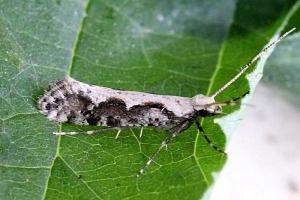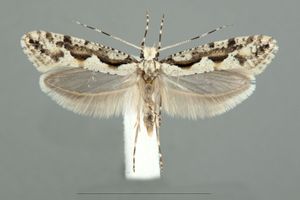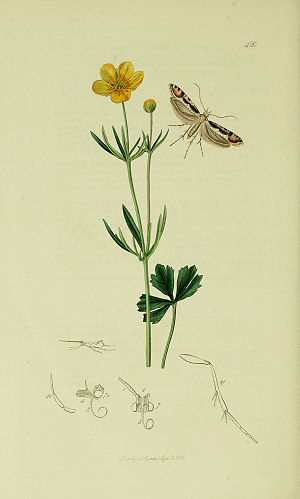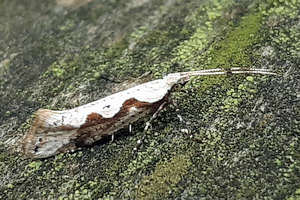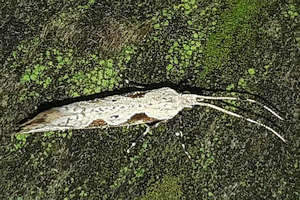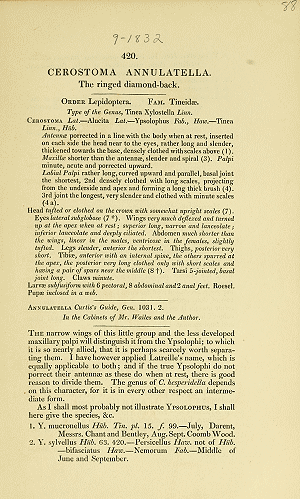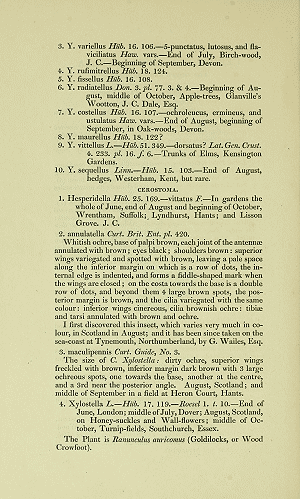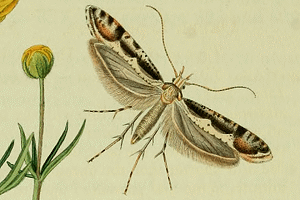

 +24Kontinente:EUAS
+24Kontinente:EUAS1. Lebendfotos
1.1. Falter
Die beiden bis 22. Juli 2012 hier eingestellten Bilder waren fehlbestimmt und wurden nach Rhigognostis incarnatella verschoben, vgl. [Forum]
2. Diagnose
2.1. Geschlecht nicht bestimmt
2.2. Ähnliche Arten
Zur Unterscheidung:
Rhigognostis incarnatella: Vorderflügel Grundfarbe dunkel rötlich-braun, teils schwärzlich; heller Bereich entlang des Hinterrandes gelblich bis ockergelb, meist durchgehend, selten zwischen mittlerer und der äußerer Ausbuchtung unterbrochen; äußere, zahnförmige Ausbuchtung relativ schmal; Fransen dunkel.
Rhigognostis annulatella: Vorderflügel Grundfarbe hell weißgrau mit schwärzlicher Zeichnung; heller Bereich entlang des Hinterrandes weißlich, nicht unterbrochen; äußere, zahnförmige Ausbuchtung relativ breit; Fransen hell.
Rhigognostis senilella: Vorderflügel Grundfarbe hellgrau dunkel braungrau und schwärzlicher gesprenkelt; heller Bereich entlang des Hinterrandes undeutlich, oft mehrmals unterbrochen; Fransen braungrau, in der Helligkeit zwischen den beiden anderen Arten.
Forumsbeitrag von [Daniel Bartsch]
2.3. Erstbeschreibung
3. Biologie
3.1. Nahrung der Raupe
- [Brassicaceae:] Cochlearia officinalis (Echtes Löffelkraut)
- [Brassicaceae:] Cardamine hirsuta (Behaartes Schaumkraut)
- [Brassicaceae:] Arabidopsis petraea [= Cardaminopsis petraea, Cardamine petraea, Arabidopsis lyrata subsp. petraea] (Felsen-Schaumkresse)
- [Brassicaceae:] Erysimum cheiri ?? [= Cheiranthus cheiri ??] (Goldlack ??)
R. annulatella gehört zu den in West- und Mitteleuropa weit verbreiteten, aber überall auffallend selten gefundenen Arten. Die Art wurde aus Schottland beschrieben und galt in Großbritannien schon immer als seltene Art der Küsten. Von der Halbinsel Portland bei Weymouth im Süden von England liegt dann auch die erste und erfreulich ausführliche Beschreibung der Raupe und ihrer Lebensweise vor: Richardson (1891: 317) geht davon aus, dass die Falter nach ihrem Schlupf Ende Juni und im Juli schnell im Winterversteck verschwinden und es erst im Frühjahr zur Eiablage kommt. Jedenfalls fand er Mitte Mai gerade erst geschlüpfte Raupen in den Blütenständen des Echten Löffelkrauts. Er teilt mit: "The plant on which it Feeds (Cochlearia officinalis) is common in many parts of Portland, but the larva seems to be rather local, as in some places it did not appear to be present, though there was plenty of the food-plant; where it occured at all, it was not uncommon, though until one knew something of its habits, one might easily pass it by unnoticed." Richardson (1891: 317) fährt fort: "The egg is apparently laid in the flower-bud, as the young larva, which could not in some cases have been hatched more than a day or two before I found it, draws together the petals slightly with silk, and lives inside them, ejecting its frass through the small gaps in its habitation between the petals. It was in this state when I first discovered in the middle of May, all the larvae at that time being rather small. As the larva grows, it gets too big for its first little house, not to mention the fact that is has eaten its contents, and for the rest of its larval life it spins a few threads of silk amongst the bunch of flowers and seed pods in a flower-head, and eats flowers, seeds, pods, leaves, and stalks, preferring them in the order in which I have named them." Die ausgewachsenen Raupen sollten sollten an den kleinen Pflanzen eigentlich leicht zu finden sein, aber Richardson (1891: 317) lehrt uns eines Besseren: "The extent to which a large larva can conceal itself in a flower-head, which seems quite open to observation throughout, is most extraordinary. I have sometimes thought that one might be present from seeing a Little eating or a thread or two of silk but could not see the larva itself until I pinched the seed-head, when it immediately rushed out [...]".
Seit dieser Arbeit galt R. annulatella immer als Art, die an Cochlearia-Arten gebunden ist, zumal der Falter in Großbritannien, Dänemark und im Süden von Norwegen ganz an Küstenhabitate mit Vorkommen dieser Löffelkräuter gebunden zu sein schien. Konkrete Raupen-Angaben aus Deutschland, der Schweiz oder Österreich - wo die Falterfunde fernab von Küstenhabitaten erfolgten, liegen nicht vor. Insofern war hier stets zu erwarten, dass die Art auch an anderen Kreuzblütlern leben müsste - aber man weiß eben nichts Konkretes (Angaben zum Goldlack (Cheiranthus sp.) beziehen sich wahrscheinlich auf R. incarnatella, solche zu Nicht-Kreuzblütlern sind sicher falsch). Hier liefern jetzt Heckford & Beavan (2011) - wieder aus Großbritannien - interessante neue Anhaltspunkte. Zunächst gelang ihnen am 21. April 2010 3 km entfernt von der Küste der Fund einer sehr kleinen Raupe an Arabidopsis petraea, aus der sich in der Zucht bis zum 27. Mai der Falter entwickelte. Im Küstenbereich von East Neap fanden sie am 12. Mai 2010 einige Raupen an Cochlearia officinalis und diverse weitere an Cardamine hirsuta - auch an Stellen ohne Cochlearia. Am 19. April 2011 gelang ihnen der Fund mehrerer weiterer Raupen an Cardamine hirsuta, diesmal bei Ben Hope, West Thumberland, 379 m, 13 km entfernt von der Küste. Cardamine hirsuta ist in Mitteleuropa ein sehr häufiges Weinbergs-Unkraut, das aber auch diverse weitere Acker und Wegrand-Biotope besiedelt. Es blüht das ganze Jahr, Hauptblütezeit ist aber von Ende März bis Anfang Mai - also genau dann, wenn R. annulatella als Raupe unterwegs ist. Gezielte Suche könnte hier Überraschungen bieten ...
(Autor: Erwin Rennwald)
4. Weitere Informationen
4.1. Andere Kombinationen
- Cerostoma annulatella Curtis, 1832 [Originalkombination]
4.2. Synonyme
- Plutella bicingulata Zeller, 1839
4.3. Literatur
- Erstbeschreibung: Curtis, J. (1823-1840): British Entomology; Being Illustrations and Descriptions of the Genera of Insects Found in Great Britain and Ireland: Containing Coloured Figures from Nature of the Most Rare and Beautiful Species, and in Many Instances of the Plants upon which they are Found. Vol VI. Lepidoptera, Part II. — [Not paginated]. London (E. Ellis & Co.).
- Heckford, R. J. & S. D. Beavan (2011): Rhigognostis annulatella (Curtis, 1832) (Lep.: Yponomeutidae) found inland and on two new larval foodplants, and a consideration of published larval descriptions. — The Entomologist's Record and Journal of Variation 123 (6): 279-282.
- Richardson, N.M. (1891): Life-history of Plutella annulatella Curt. — The Entomologist's Monthly Magazine, 27: 317-319. [zum Digitalisat auf biodiversitylibrary.org]
- SCHÜTZE (1931): 96

























